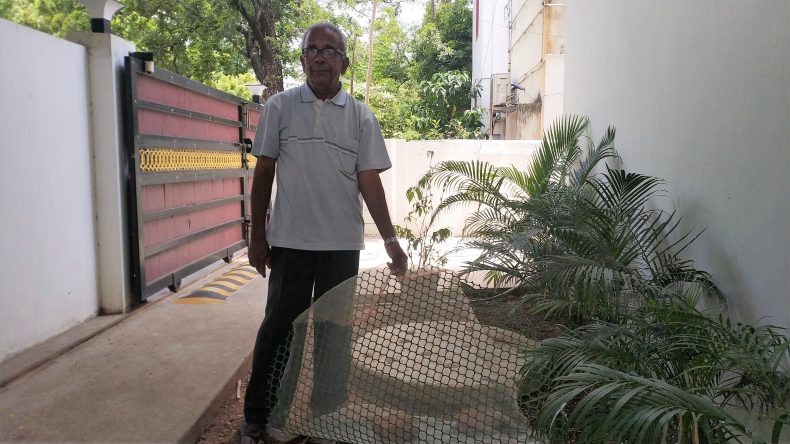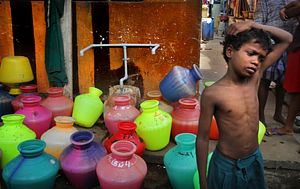For 15 minutes on an August afternoon in Chennai, the skies opened and rainwater throttled the streets of India’s sixth-largest metropolis. Inside a café in the city’s Adyar district, the sous chef, 26-year-old P. Selvakumar, gazed out the window as water quickly pooled at the edges of the road, submerging its sidewalks. “If the rain is much more than this,” he said, “the whole road will be closed.”
Chennai was eagerly awaiting steady rain to ease what longtime observers call the city’s worst drought in decades. After experiencing poor rainfall in last autumn’s monsoon season, Chennai’s four main reservoirs ran completely dry. Empty plastic water jugs line the streets as residents await tanker deliveries from public and private trucks. The crisis, which made global headlines earlier this summer, has dragged through brutal waves of July and August heat, leading schools, hotels, and restaurants to close and companies to ask employees to work from home. In July, two trains began carrying 1 million liters of water per day – still well short of Chennai’s water needs – from Jolarpetti, about 135 miles from Chennai, into the city.
Less than four years ago, Chennai saw devastating floods that took at least 422 lives in Tamil Nadu and caused up to $14 billion in damages. But most of that rainwater flowed into the sea, lost forever to Chennai’s parched groundwater reserves. As the coastal city anticipates its upcoming autumn monsoon season, residents and experts have criticized authorities for failing to rehabilitate a notoriously mismanaged water supply.
Tamil Nadu’s ruling party, the All India Anna Dravida Munnetra Kazhagam (AIADMK), has urged calm amid reports of protests and clashes in the state. In June, Indian media reported that an activist was beaten to death by neighbors after becoming angered at their attempts to store large amounts of water. People living outside of Chennai have blocked tankers from entering the city, fearing their own water supply would be sacrificed to supply the city center. Edappadi K. Palaniswami, the chief minister of Tamil Nadu, told the public in June they would be able to manage until the monsoon. “In case of a water issue somewhere,” he said, “it should not be blown up to give a false impression that the entire state is reeling from water scarcity.”
The drought, however, has amplified not only past failures to preserve Chennai’s water supply, but a future in which water scarcity will become normalized. Data published in August by the World Resources Institute indicates a quarter of the world’s population – including the approximately 10 million people of Chennai – face an imminent water crisis. NITI Aayog, an Indian government think tank, predicted in June that 21 Indian cities would run out of groundwater in 2020. A report by the London-based risk analytics firm Verisk Maplecroft named Chennai as facing an “extreme risk” of water stress, saying its present crisis “could be the new normal for tens of millions of people” in India’s urban centers.
“Future droughts are going to be more severe,” said Sekhar Raghavan of the Adyar-based NGO Rain Center. “This is a wake-up call for us. If you’re not going to wake up now, you’ll never wake up.”
Raghavan, 72, has long been the city’s foremost advocate of improving the city’s rainwater harvesting. Chennai, he said, gets an average of 54 days of rain per year, yielding an average rainfall of about 140 centimeters (55 inches). Its failure to collect the rain that falls, especially during poor monsoons such as that of last autumn, leads to what he called a “man-made” crisis of scarcity.
“Unless we capture the rain that falls in those 54 days, we will run out of water,” he said. “It’s as simple as that.”
Under former Chief Minister J. Jayalalithaa, who served in the role for over 14 years until her death in 2016, Chennai made rainwater harvesting compulsory, requiring every building to install a water catchment system on its rooftop and pour the collected rainwater into the ground. Just after the law’s August 31, 2003, deadline for systems to be installed, however, Raghavan and his NGO surveyed 309 plots in the Gandhi Nagar neighborhood of Chennai and found that only around 40 percent of buildings were in compliance – far short of the 99 percent compliance rate touted by the government at the time.
“Even with 40 percent compliance,” said Raghavan, “the impact was very good.” The following three years brought heavy rains and, he said, dramatically raised the groundwater level, filling dry open wells for the first time in decades.
But the enthusiasm for rainwater harvesting did not grow from there. In 2015, Raghavan and Chennai-based environmentalist Indukanth Ragade conducted an audit of homes, apartments, and government buildings, including offices and police stations. Ragade told Bangalore-based The News Minute that the audit showed how government buildings “got rainwater harvesting methods entirely wrong,” with efforts plagued by broken and clogged pipes and shoddy maintenance of drains and bore pits. The Greater Chennai Corporation, the civic body that governs the city, has ordered that harvesting structures throughout the city be inspected.
“We don’t harvest enough rainwater,” he said. “Had we done it, the gravity of the water shortage we are facing today could have been avoided.”
In the Rain Center’s Adyar office, Raghavan repeatedly paused our conversation to field phone calls from residents and business owners seeking advice on installing harvesting systems. When the harvesting legislation was passed in 2003, people “thought it was a draconian law,” he said. “People did not know what harvesting was.” Now, Raghavan said he receives around 20 calls a day asking for advice on how to harvest rainwater – but, in a city of about 10 million, he worried this is still not enough.
“Rainwater harvesting is not an option. It’s not an alternative,” he said. “Unless you learn to live with less water, unless you harvest rainwater, you’re going to be in deep trouble.”

Sekhar Raghavan. Photo by Nick Aspinwall.
Chennai is in the midst of a rapid development boom that has transformed the city. During the long reign of Jayalalithaa, it established itself as the country’s automobile production hub, earning it the moniker “India’s Detroit.” The city’s IT Corridor, a 45-kilometer stretch of glistening high rises, plays host to dozens of corporate giants such as Tata and Foxconn.
But the push for growth neglected the precariousness of Chennai’s groundwater supply. Bodies of water that once acted as catchment areas and flood relief basins have been blocked, paved over, and used as foundations for new apartments.
The present crisis is being felt by all residents in the city, whether rich or poor. But the scarcity has played out differently for the people of Chennai depending on their existing social power, according to Karen Coelho, an associate professor at the Madras Institute of Development Studies. Coelho wrote that some of Chennai’s wealthiest neighborhoods “had water on tap all day even in June” while others – especially areas newly incorporated when Chennai expanded its municipal boundaries in 2011, including both “elite enclaves on the IT corridor and poorer settlements on the peripheries” – are still unconnected to the city’s pipe grid. Many households in Chennai have sunk their own borewells or relied on private tankers, noted Coelho, and as a result, over the last decade, the city has seen an 85 percent decline in its groundwater levels.
This presents a daunting scenario for any municipal planner, and as the city expands and monsoon rains remain unpredictable, it projects to get only worse.
The Chennai Metropolitan Water Supply and Sewage Board, which is responsible for the city’s water supply, has pushed for lakes to be desilted, allowing them to be used for water storage. The process is now underway, but only after years of inaction. In a June public hearing, the Madras High Court criticized the AIADMK-led state government for having mismanaged the looming water crisis by failing to desilt water bodies, prevent rainwater from flowing into the sea, and educate people about rainwater harvesting.
The state government said in response it has begun to set up 270 water purification centers and has recently begun construction on Chennai’s third desalination plant, after which the government said the city will no longer have to rely on monsoon rains.
Not everyone is buying the latter claim, however. According to Raghavan of the Rain Center, desalination plants – which make salt water drinkable, albeit at a prohibitively high cost of construction, operation, and environmental impact – “should be the last thing” to consider.
“A lot of rainwater on the road is dumped into the sea every year by corporations,” he said. “And we try to take out sea water and make it into freshwater. That’s not a wise thing to do, right? They make money in both.”
Nearly as unavoidable as the sight of empty water jugs in Chennai is a prevailing cynicism that those in government and business have been too willing in their mismanagement of the water crisis – for instance, officials are regularly accused of personally profiting from private water distribution. The result is a breakdown in civic trust, which runs the risk of explosion every time the city’s taps run dry.
As he watched rainwater pool in the street, destined to run off into the sea, Selvakumar, the sous chef, expressed anger at the government. This resentment, shared by many in Chennai, all too often serves as a launch pad for sensational theories, justified or otherwise, that spread like wildfire in India’s highly polarized, disinformation-infested online ecosystem.
The crisis has also inflamed decades-old political squabbles between Tamil Nadu and neighboring states. In June, Kerala offered to send 2 million liters of water by train to Tamil Nadu. Palaniswami, the chief minister of Tamil Nadu, rejected the offer, calling it insufficient and urging Kerala to raise the water level in the Mullaperiyar dam – located in Kerala but run by Tamil Nadu, and at the heart of an age-old dispute between the two states. While Tamil Nadu has urged Kerala to allow it to raise the maximum level of the dam – which is crucial to power production and irrigation in Tamil Nadu – local residents have resisted such a move, fearing it would leave their homes prone to extreme flooding. Tamil Nadu has also been embroiled in a water dispute with nearby Karnataka. Its other neighbor, Andhra Pradesh, began releasing river water to Tamil Nadu earlier this month.
But Raghavan quickly became incredulous when discussing south India’s inter-state political quarreling. “I still see that rainwater is not being harvested. It rolls into the street,” he said, noting that Chennai is, in theory, extremely well equipped to retain its rainwater.
“No other city in India has this much harvesting built in it,” he said, referencing the Jayalalithaa-era harvesting law. “In that sense, we call Chennai a success story. But,” he sighed, “it’s not enough.”

































